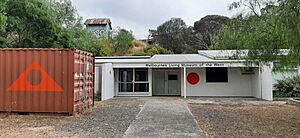Melbourne's Living Museum of the West facts for kids
 |
|
| Established | 1984 |
|---|---|
| Location | Maribyrnong, Melbourne, Australia |
| Type | Culture museum |
Melbourne's Living Museum of the West is a special kind of museum in Melbourne, Australia. It's called an ecomuseum, which means it focuses on the environment, landscape, and the stories of people living there. It's also a community museum that collects and shares the history of people in Melbourne's western suburbs, especially in Maribyrnong. The museum started in 1984. This was part of Victoria's 150-year anniversary celebrations. Other museums like the Children's Museum also opened around that time.
Contents
What is the Living Museum?
How the Museum Started
People often call it simply the Living Museum. It began in 1984 because the western part of Melbourne needed more cultural places. This area was mostly for working-class people and factories. The idea of an ecomuseum was chosen. This meant the museum would focus on the local environment, the land, and the culture of the people. It was important for the community to help record and save their own stories.
A Museum Without Walls
The Living Museum was Australia's first ecomuseum. It tells the stories of people from Melbourne's Western Region. This area stretches from Footscray to Bacchus Marsh, and from Sunbury to Werribee. At first, it was planned to be a "museum without walls." This meant it would focus on recording people's spoken stories (oral history) and getting the community involved. It didn't collect many old objects until more recently.
What the Museum Collects
Stories and Photos
The Living Museum has a large collection of resources. It includes over 10,000 documents, photographs, and audio recordings. It also has some objects. These items are kept at the museum's resource center. The collection has published books, reports, and articles. There are also maps, plans, and drawings. A big part of the collection is the photo archive.
Oral Histories and Artefacts
The museum also has many oral histories. These are recordings of people telling their own stories. The collection focuses on important topics like migration, work, and the environment. It also covers culture, heritage, and industry. The museum collects everyday stories of people from Melbourne's West. It has about 500 objects and 5,000 copies of historical documents. There are also 10,000 photos, both old ones and new ones.
Where the Museum is Located
Moving to Pipemakers Park
The Living Museum first started in a small house in David Street, Footscray. It grew bigger and needed more space. With help from Arts Victoria, it moved to a renovated industrial site. The museum is now in old factory buildings at Pipemakers Park. This park is on Van Ness Avenue in Maribyrnong.
The Museum Buildings
The buildings were fixed up between 1987 and 1988. This was done with a $2 million grant for the Australian Bicentenary. Parks Victoria owns these buildings. The Living Museum has a special agreement to use them. The site has a visitor and research center. It also has staff offices. There is a large exhibition space in the old bluestone industrial buildings. These spaces are used for many things. They host exhibitions, concerts, performances, and community events. The museum's special supporter is Joan Kirner, who used to be a leader in Victoria.
Recent Updates
Changes and New Beginnings
Around 2011, the Living Museum faced some challenges. It lost its main funding from Arts Victoria. This made it hard to get enough money to keep going. For a while, a group of local artists wanted to use Pipemakers Park for their studios. However, they were outvoted in 2011.
Digitizing the Collection
In 2012, the Living Museum reorganized its collection. It moved everything back into the Visitor Centre at Pipemakers Park. The museum has been working to make its collection digital. This means putting photos, documents, and stories online. A new group of people now manages the museum. This group includes both original and new members. The Living Museum continues to create new exhibitions and events. These events take place in the historic buildings along the Maribyrnong River.
See also

